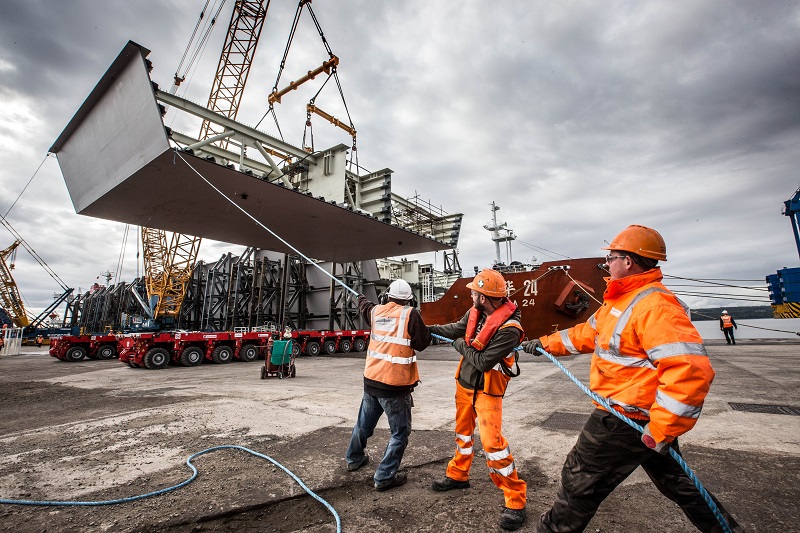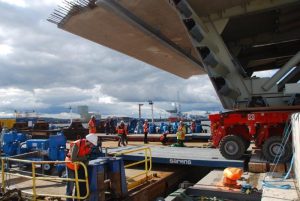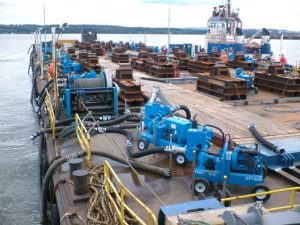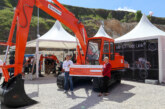
Sykes Pumps’ ballasting expertise helps make Forth Bridge scheme plain sailing
While the iconic red structure of the adjacent Forth Bridge rail crossing may have the honour of being named a Unesco World Heritage Site, the sudden closure of the Forth Road Bridge last December was a stark reminder of just how many vehicles travel from the North of Edinburgh to the East on the Forth Road Bridge.
The existing road bridge was opened in 1964 and the volume of traffic using it has increased many times over since then.
To reduce congestion and structural wear and tear, an additional crossing is now under construction. The Forth Replacement Crossing (FRC), also known as the ‘Queensferry Crossing’ is Scotland’s biggest transport infrastructure project in a generation with an estimated build cost of £1.35 billion.
Once completed later this year it will be the longest three tower cable-stayed bridge in the world and by far the largest to feature cables that cross mid-span.
Precise Ballast
The 1.7 mile long bridge is being constructed by the Forth Crossing Bridge Constructors (FCBC) consortium comprising Hochtief, American Bridge, Dragados and Morrison Construction.
The scheme involves the use of 42,000 tonnes of steel to fabricate the bridge span, forming a base for the concrete
deck. With the bridge’s three towers already in-situ in the estuary, the deck is being floated out in pre-fabricated sections that can then be lifted into place at either of the two lifting locations at each tower.
 Each steel section is delivered to site and once the concrete road surface has been poured by the FCBC team the completed deck is loaded onto a barge via self-propelled modular trailers (SPMTs) by FCBC before being floated out onto the estuary.
Each steel section is delivered to site and once the concrete road surface has been poured by the FCBC team the completed deck is loaded onto a barge via self-propelled modular trailers (SPMTs) by FCBC before being floated out onto the estuary.
It’s a painstaking process that requires specialist understanding of the ballasting requirements to ensure the safety of the site team and prevent any risk of the vessel capsizing or sinking during the delicate operation.
“Each section of steel and concrete weighs around 700 tonnes,” explains Alister Smith, project manager at Sarens, the heavy lifting and engineered transport specialist contracted to execute the load outs.
“It requires specialist vessels with tanks in their hulls to enable exact amounts of water to be pumped in or out as ballast throughout the load on process.”
Sarens has wide-ranging experience of loading heavy materials and equipment in this way, including the float out of the Panama Canal gates in 2015. The company has its own vessels and fleet of pumps but, for the FRC project, it worked with Sykes Pumps.
The pump hire specialist was able to supply the required number and specification of pumps from its depot network, along with specialist expertise in ballasting calculations and on-site support for installation and commissioning throughout the scheme.
Richard Box, load out specialist at Sykes Pumps, comments: “An efficient load out operation relies on the right specification of pumps and pipework, reliable equipment, accurate calculations and ease of operation for the site team.
Sykes Pumps’ experience of similar projects meant that were able to add value for Sarens with technical advice as well as pump assets.”
Optimised Efficiency
With a nationwide hire fleet and depot network, Sykes Pumps was able to supply the 50 x GP150M diesel pumps required for the operation, and provide localised service from its closest depot in Stirlingshire.
 The 700 tonne sections of prefabricated steel and concrete deck were transferred onto float out barges using SPMT vehicles and the Sykes team worked with Sarens to calculate the ballast requirements for the load on and load off manoeuvres, as the weight shifted from the shore to the floating vessel.
The 700 tonne sections of prefabricated steel and concrete deck were transferred onto float out barges using SPMT vehicles and the Sykes team worked with Sarens to calculate the ballast requirements for the load on and load off manoeuvres, as the weight shifted from the shore to the floating vessel.
In addition to providing the pumps themselves, each of which is capable of a maximum flow rate of 90 l/s, Sykes Pumps recommended the use of additional fittings and butterfly valves for the pumps to provide dual suction and discharge.
Richard continues: “We invested in the additional accessories to provide Sarens with the best possible solution within a one-stop-shop hire contract. The dual suction and discharge reduced the number of pumps and personnel required on site, optimising efficiency for the ballasting operation.”
Sarens used two load out vessels for the project, each with 25 pumps from Sykes. The butterfly valves enabled the site team to switch each pump between suction and discharge quickly and simply, ensuring the ballast was adjusted as per the calculations in real time.
Pump maintenance is included in all Sykes’ pump hire contracts and for this project, the company has also provided on-site support from Richard for a couple of days per week throughout the load out programme.
“We have worked with Sykes Pumps several times before,” Alister adds. “We were not only confident that they had the fleet availability we needed but also that they could work with us on the ballast plans, ensuring that the water pumped into and out of the vessels’ tank compartments is calculated accurately. The company’s collaborative approach to helping us deliver this scheme has been invaluable.”








